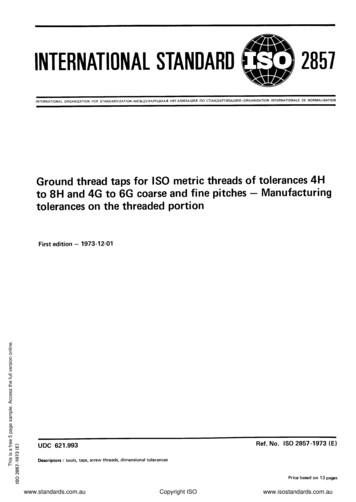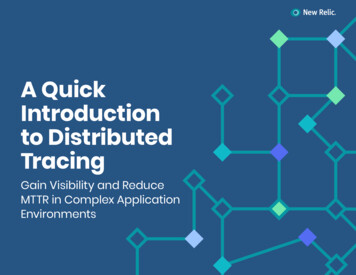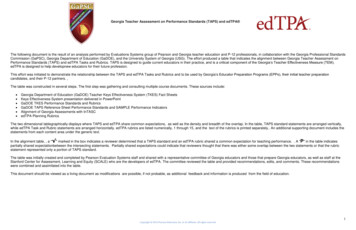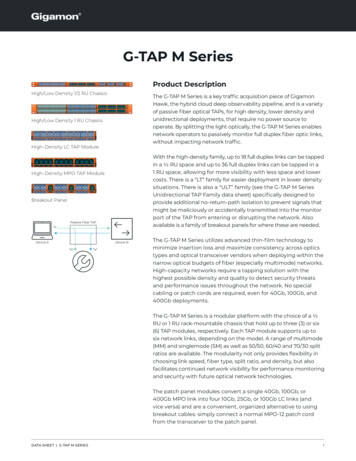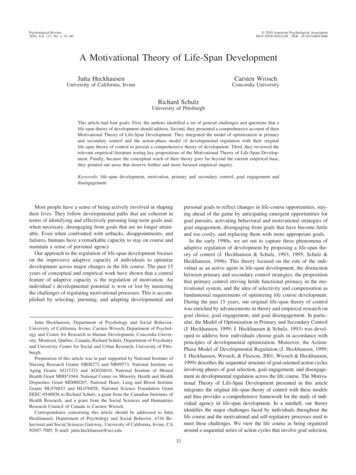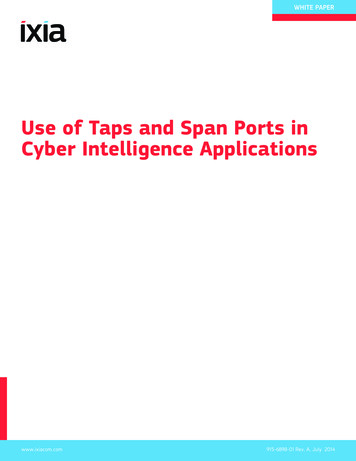
Transcription
WHITE PAPERUse of Taps and Span Ports inCyber Intelligence Applicationswww.ixiacom.com915-6898-01 Rev. A, July 2014
2
Table of ContentsIntroduction. 4Problem #1: Dropped Packets. 5Problem #2: The Need for Switch Configuration . 6Problem #3: Vulnerability to Attack . 6Problem #4: Not Passive. 7The Tap Alternative. 7Conclusion. 93
Cyber warfare is unfortunately no longer found only in speculative fiction; it is with ustoday. Distributed denial-of-service (DDoS) attacks have been launched against the UnitedStates, South Korea, Kyrgyzstan, Estonia, and Georgia in recent years, and military andgovernment computer systems around the world are assaulted by intruders daily. Someattacks come from nation-states, but others are perpetrated by transnational and unalignedrogue groups. Those bent on inflicting harm on nations and citizens not only use networksas an attack vector, but also for organizing, recruiting, and publicizing their beliefs andactivities.Terrorisminformaticsanalyzes informationfrom data-at-restsources such asblogs, social media,and databases.On the other side of the fence are the good guys, the members of the cyber intelligencecommunity who aim to understand and track the terrorists, and ultimately stymie theirplans. Due to the pervasive use of networks by radical and criminal organizations in themodern world, a great deal can be learned about terrorists by examining their use ofthe World Wide Web, and how the Internet is used as a vector to attack both public andprivate systems. This field of study is called “terrorism informatics,” which is definedas “the application of advanced methodologies and information fusion and analysistechniques to acquire, integrate, process, analyze, and manage the diversity of terrorismrelated information for national/international and homeland security-related applications”(Hsinchun Chen et al, eds., Terrorism Informatics. New York: Springer, 2008, p. xv).Terrorism informatics analyzes information from data-at-rest sources such as blogs,social media, and databases. For other types of analyses, it is necessary to examine datain motion, in other words, information a s it travels on a network. Access to data-in-motionis often obtained by eavesdropping on the network traffic using Span ports in switches.This paper focuses specifically on the implications of using Span ports in counterterrorism monitoring applications. It shows that Span ports are particularly ill-suited tothis use. Note also that the security vulnerabilities of Span ports in counter-terrorismapplications apply equally when Span ports are used for other monitoring needs such asperformance or compliance monitoring.IntroductionSpan or mirror ports are a convenient and inexpensive way to access traffic flowingthrough a network switch. Switches that support Span ports—typically high-endswitches—can be configured to mirror traffic from selected ports or VLANs to the Spanport, where monitoring tools can be attached. At first glance, it seems that a Span portcould be a good way to connect an intrusion detection system (IDS), forensic recorder, orother security monitoring device.Mirrored TrafficSwitchSwitchMonitoring DeviceSwitchSwitchSpan Ports Mirror Traffic for Monitoring4
Unfortunately, Span ports have several characteristics that can be troublesome and riskyin a counter-terrorism application. These characteristics include: The possibility of dropping packets The need for reconfiguring switches The vulnerability of Span ports to attack The fact that Span ports are not passive mechanismsThese issues are elaborated in the following sections.Problem #1: Dropped PacketsThe first issue with Span ports in a counter-terrorism application is that the visibilityof network traffic is less than perfect. In counter-terrorism monitoring, a fundamentalrequirement is that the security device must be able to see every single packet on thewire. An IDS cannot detect a virus if it doesn’t see the packets carrying it. Span portscannot meet this requirement because they drop packets. Spanning is the switch’s lowestpriority task, and Span traffic is the first thing to go when the switch gets busy. In fact,it is allowable for any port on a switch to drop packets because network protocols arespecifically designed to be robust in spite of dropped packets, which are inevitable in anetwork. But it is not acceptable in a counter-terrorism monitoring application.Span port visibilityissues go beyondsimply droppingpackets.Different switches may be more or less prone to drop Span packets depending on theirinternal architecture, which varies from switch to switch. However, it is unlikely that theperformance of the Span port was evaluated as an important criterion when the switchinggear was selected. As a counter-terrorism professional, you probably don’t want yoursecurity strategy to be dependent on a procurement policy that you don’t control.Nevertheless, suppose you do have switches with the best possible Spanningperformance. Dropped packets may still be an issue depending on how much traffic youneed to send through the Span port. If you need to see all of the traffic on a full-duplex 1Gigabit link, a 1 Gigabit Span port won’t do the job. Full duplex link traffic exceeds the 1Gigabit SPAN port capacity when link utilization goes above 50 percent in both directions.To see all the traffic, you need to dedicate a 10 Gigabit port for Spanning, and now theSpan port doesn’t seem so inexpensive any more.However, Span port visibility issues go beyond simply dropping packets. Being switchtechnology, Span ports by their very nature are not transparent for layer 1 and layer 2information: for example, they drop undersized and oversized packets, and packets withCRC errors. They usually remove VLAN tags, too. In addition, Span ports do not preservethe packet timing of the original traffic, or in some cases even the packet order. Thistype of information can be critical for detecting certain types of network attacks suchas network worms and viruses, and for some behavior-based packet classificationalgorithms. For example, network consultant Betty DuBois observed, “[Regarding] losingthe VLAN tag information when Spanning, if there is an issue with ISL or 802.1q, how will Iever know with a Span port?” -or-t.html)5
Problem #2: The Need for Switch ConfigurationAnother issue with using Span ports in a counter-terrorism application is the very fact thatthe switch needs to be configured to send specific traffic to the Span port. This fact leadsto a host of complications: The configuration may not be done correctly. “If the switch owner mistakenly orintentionally configures the Span port to not show all the traffic it should, you mayor may not discover the misconfiguration. I have seen this happen countless times,”said Richard Bejtlich, the highly respected author of The Tao of Network SecurityMonitoring. (http://www.governmentsecurity.org/All/Why Network Taps) Sharing the Span port. A switch typically supports only one or two Span ports, andthe network administrator or someone else may need to use “your” Span port forone reason or another. They may or may not tell you when the Span traffic profile ischanged for their needs. IT Manager Bob Huber recalled, “Span was a huge issue we dealt with on the IDS team where Iused to work. We had constant issues with the Span going up and down. When thereare network issues to deal with, the network engineers have priority to the limitednumber of Span ports available. Hoping they remember to reconfigure your Span portwas a waste of time.” mmentaryon-span-and-rspan.html) Switch configuration may not be available when you need it. If you need to change theprofile of the traffic you are Spanning, or change it back after someone else used theport, it may not be easy to get the switch owner’s time to do it. In larger organizations,you may also need to get the change authorized through a Change Control Board, andthen wait for a maintenance window to get it implemented. Changes to the network switches for other reasons can impact the Span traffic.Networks are constantly being reconfigured to optimize applications or support newrequirements. If the counter-terrorism monitoring solution depends on Span ports, itis vulnerable to changes (planned or surprises) any time the network is reconfiguredfor any reason. Switch configuration itself is a security vulnerability. In any counter-terrorism activity,the network’s security is of course paramount. Switches are a highly vulnerablenetwork point, and the ability to reconfigure them must be tightly controlled. Doesit make sense to require switch reconfiguration as part of the counter-terrorismmonitoring solution, when reconfiguring a switch can accidentally or deliberatelyexpose or bring down the network? If you have any doubt that Span port misconfiguration can be an issue, take a lookat this note in the Cisco Catalyst 6500 Series documentation: “Connectivity issuesbecause of the misconfiguration of Span ports occur frequently in CatOS. Bevery careful of the port that you choose as a Span destination.” s708/products tech note09186a008015c612.shtml#topic8-1)Switch configurationitself is a securityvulnerability.Problem #3: Vulnerability to AttackSpan ports are usually configured for uni-directional traffic, restricted to transmittingtraffic to the monitoring device. However, in some cases they can receive traffic as well(a feature Cisco calls ingress traffic forwarding), in order to enable management of themonitoring device over the same switch port and monitoring device NIC as the mirrortraffic. When this configuration is used, the Span port becomes an open ingress port to6
the switch, creating a serious security vulnerability. Therefore, this configuration shouldbe avoided as a best practice. If for some reason it becomes necessary to use thisconfiguration, you should at least lock the Span port to the monitoring tool’s MAC addressif possible, so an unauthorized user won’t be able to plug a laptop into the connection andhack the switch.Problem #4: Not PassiveA final important consideration when using Span ports for counter-terrorism monitoringaccess is that Span ports are not passive: They can affect the performance of theswitch’s other ports. For example, Gerald Combs, the father of Wireshark, warns, “Someswitch families (e.g., the Cisco 3500 sercies) don’t set a lower priority on Span traffic,and will slow down the backplane in order to deliver packets to a Span port.” -or-t.html) This effect violates a primaryprincipal of security and especially forensic monitoring, that monitoring should not affectthe traffic being monitored. It may have legal as well as practical implications.The Tap AlternativeTo avoid the problems that Span ports bring to counter-terrorism monitoring applications,security experts like Bejtlich recommend using traffic access ports (Taps) for access tothe network traffic. Taps are specifically designed to provide 100 percent traffic visibilitywithout any impact on monitored traffic. Optical Taps for fiber links use optical splitters todivert part of the light from the link to a monitor port, creating a true copy of the link trafficall the way down to layer 1 and layer 2 errors. Taps for copper links perform a similarfunction electronically. Optical Taps do not use any power at all, while copper Taps includerelays which ensure that link traffic continues to flow even when the Tap loses power.FirewallSwitchTo avoid theproblems thatSpan ports bring tocounter-terrorismmonitoringapplications,security experts likeBejtlich recommendusing traffic accessports (Taps).SwitchNetwork TapMonitoring DeviceFully passive fiber network Tap with optical splittersTaps avoid all of the pitfalls of Span ports in counter-terrorism applications: Taps send the monitoring tool an exact copy of the link traffic, including layer 1 andlayer 2 errors and malformed packets, no matter how busy the link is. They never droppackets. Taps require little or no configuration. Once a Tap is installed in a link, monitoringaccess to the link traffic is always available, consistently and persistently. Taps are secure. They do not have an IP address so attackers cannot see them, andthey cannot inject traffic into the network under any circumstances. In fact, a Tapactually hides the monitoring tool from the network as well, providing true “stealth”monitoring.7
Taps are completely passive. They cannot affect the link traffic, not even if they losepower.Tap technology has evolved to offer a range of additional features as well, most of whichare not available with Span ports. (Note that some of these features require a trade-offwith the previously mentioned characteristics.)Tap technology hasevolved to offer arange of additionalfeatures as well,most of which arenot available withSpan ports. Regeneration Taps produce multiple copies of the link traffic so multiple tools andmultiple users can view the same traffic simultaneously. Your counter-terrorismmonitoring device does not need to give up access when the network administratorneeds to put an additional protocol analyzer onto the link. Aggregator Taps combine the traffic from both directions of full-duplex links andfrom multiple links and sends it to a single NIC on the monitoring tool. No packets aredropped as long as the aggregated traffic does not exceed the monitor port bandwidth. Active Response Taps permit monitoring tools to send response packets such as TCPresets, ICMP messages, and ACL changes into the tapped link. This feature can beused by an IDS to take action when certain types of intrusions are detected. (ActiveResponse Taps are an exception to the Tap “one direction only” traffic rule.) iTaps provide a remote management interface and basic monitoring data about linktraffic, such as packet counts and utilization levels. (Remote management interfacesrequire IP addresses, but they are secured with passwords, SSH, HTTPS, and othermeasures.) Media Conversion refers to Taps that support different media types on their networkand monitor ports. Many Taps have pluggable SFP or XFP ports enabling differentmedia types to be accommodated simply by plugging in different transceiver types.Some Taps even perform 10 Gigabit to 1 Gigabit and 1 Gigabit to 10 Gigabit data rateconversion as well. Filter Taps enable mirrored traffic to be restricted to particular protocols, sourceand destination IP addresses, VLANs, ports, and other criteria, making it easier toisolate or troubleshoot issues, and relieving monitoring tools from spending valuableprocessing cycles on pre-filtering traffic. For example, the Net Optics Director DataMonitoring Switch supports filtering as well as regeneration, aggregation, remotemanagement, and media conversion, all in a single device. Bypass Switches create fail-safe access ports for in-line devices such as intrusionprevention systems and firewalls.The wide range of Tap devices available today enable appropriate monitoring access to bebuilt into all parts of the network architecture, at the edges, distribution, LAN, and core.Such a Monitoring Access Platform (MAP) does not depend on Span ports for strategicinformation access, but in fact frees up the Span ports for tactical monitoring accesswhen special needs arise. Permanent and ongoing counter-terrorism monitoring can relyon a Tap-based MAP for consistent, persistent, and secure monitoring access, immune tothe vagaries of day-to-day network administration and management.8
InternetForensicAnalyzerNetwork TapiTap IPSIDSIDSForensicDirector IDSRegeneration Tap AnalyzerForensiciBypass SwitchRMONONAnalyzerOFFRMONLink AggregatorIPSMatrix SwitchWIFIRMONAnalyzerAnalyzerIntegrated Monitoring Access Platform Based On Tap TechnologyConclusionMonitoring is an essential building block of Bejtlich’s “defensible network architecture,”the first of its seven key characteristics: monitored, inventoried, controlled, claimed,minimized, assessed, and current. enetwork-architecture-20.html) Utilizing Span ports for counter-terrorism monitoringaccess is placing that building block on a weak foundation, subject to packet loss,misconfiguration, and intrusion. A Monitoring Access Platform, based on Tap technologyand integrated within the network architecture, is an alternate access approach thatprovides a solid base on which to build your network’s security and counter-terrorismapplications.Utilizing Spanports for counterterrorism monitoringaccess is placingthat buildingblock on a weakfoundation, subjectto packet loss,misconfiguration,and intrusion.9
WHITE PAPERIxia Worldwide Headquarters26601 Agoura Rd.Calabasas, CA 91302(Toll Free North America)1.877.367.4942(Outside North America) 1.818.871.1800(Fax) 818.871.1805Ixia European HeadquartersIxia Technologies Europe LtdClarion House, Norreys DriveMaidenhead SL6 4FLUnited KingdomSales 44 1628 408750(Fax) 44 1628 639916Ixia Asia Pacific Headquarters21 Serangoon North Avenue 5#04-01Singapore 554864Sales 65.6332.0125Fax 65.6332.0127www.ixiacom.com915-6898-01 Rev. A, July 2014
The vulnerability of Span ports to attack The fact that Span ports are not passive mechanisms These issues are elaborated in the following sections. Problem #1: Dropped Packets The first issue with Span ports in a counter-terrorism application is that the visibility of network traffic is less than perfect.
